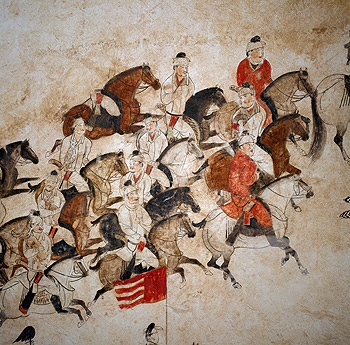Kua
/ Kumar Frantzis defines the kua as "the area on each side of the body extending from the inguinal ligaments through the inside of the pelvis to the top (crest) of the hip bones." As a quick reference while teaching I usually demonstrate sinking or folding at the kua and then define it as: the inside of the hip socket all the way up into the torso. But definitions aside, most martial artists would agree that this region is extremely important.
Kumar Frantzis defines the kua as "the area on each side of the body extending from the inguinal ligaments through the inside of the pelvis to the top (crest) of the hip bones." As a quick reference while teaching I usually demonstrate sinking or folding at the kua and then define it as: the inside of the hip socket all the way up into the torso. But definitions aside, most martial artists would agree that this region is extremely important.An accurate conception of the kua is a prerequisite to both seeing and feeling movement in or from the kua. An
 inaccurate conception of the anatomical reality of this region leads to poor functionality.
inaccurate conception of the anatomical reality of this region leads to poor functionality.And lately I've been thinking about horses.
The horse stance is the most important stance in North Asian martial arts, it is usually the first stance students learn. I recently read that in many parts of China, being
 possessed by a deity was called, "being ridden as horse." I have else where stated that I thought the real difference between internal and external martial arts is that internal martial arts are training for not becoming possessed and external martial arts are training for surviving the experience of possession. I got this theory from studying Haitian dance and other African dance/music traditions. In these traditions some people are trained to not become possessed and some people are expected to become possessed. The dance training seems to make it possible for a possessed person to do very wild and otherwise dangerous movements without getting hurt. In Haiti they also call being possessed by a deity, "being ridden as a horse."
possessed by a deity was called, "being ridden as horse." I have else where stated that I thought the real difference between internal and external martial arts is that internal martial arts are training for not becoming possessed and external martial arts are training for surviving the experience of possession. I got this theory from studying Haitian dance and other African dance/music traditions. In these traditions some people are trained to not become possessed and some people are expected to become possessed. The dance training seems to make it possible for a possessed person to do very wild and otherwise dangerous movements without getting hurt. In Haiti they also call being possessed by a deity, "being ridden as a horse."People used to spend a lot more time around horses.
I think the concept of the kua comes from spending time with horses. The kua is not only a great source of power in the horse, it is also the place where we control a horse. A horse rider goads her horse in the kua! That's where you stick the spurs!
In Northern Shaolin, the forms all open with a cat stance and then a horse walk. I've been thinking about and practicing this simple basic horse walk a lot lately. It uses a long, low, step with a flicking action of th
 e toes which is supposed to send sand up into the eyes of someone attempting to chase you. Why is it called the horse walk?
e toes which is supposed to send sand up into the eyes of someone attempting to chase you. Why is it called the horse walk?This walk involves a hollowing out of the kua and a forward orientation of the torso, with no side to side movement. Is this technique designed to try to get the student to think about generating power as if she were a horse?
UPDATE: I really don't know much about horse riding. Looking around for images I noticed that most people are spuring the horse further forward than I imagined. But I have heard that in the old days, when horses were smaller, Chinese riders tied their legs back. So their feet would have been right in the kua. Where are the horse experts when you need them?
